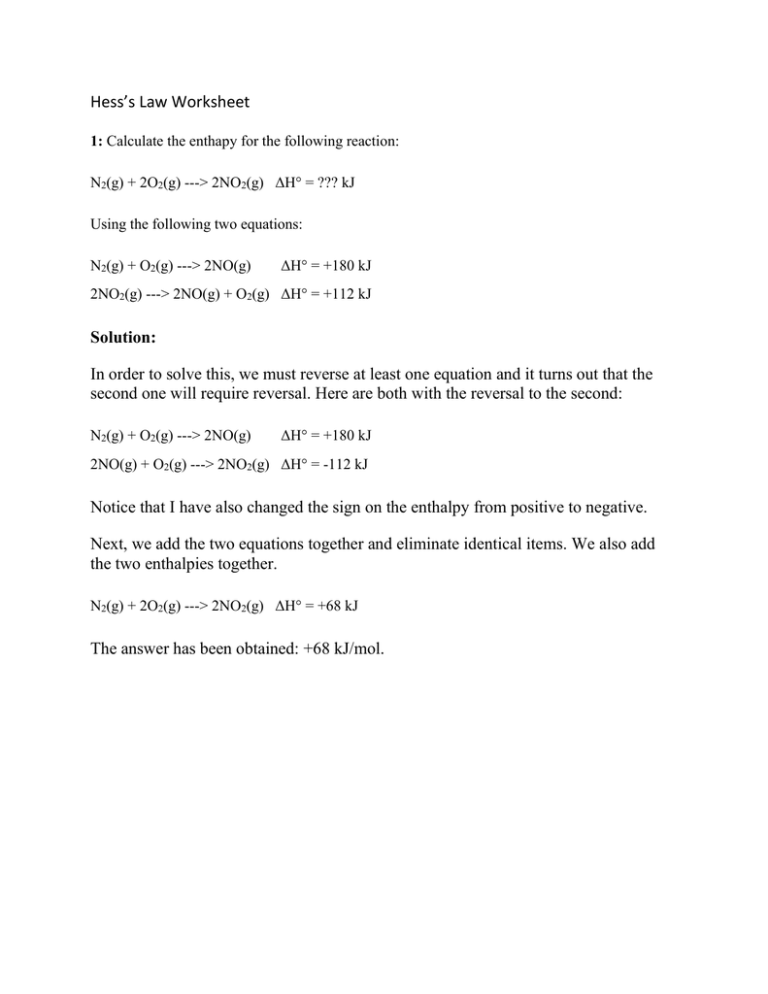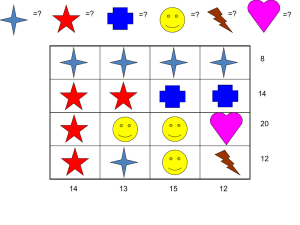Hess's Law Key
advertisement

Hess’s Law Worksheet 1: Calculate the enthapy for the following reaction: N2(g) + 2O2(g) ---> 2NO2(g) ΔH° = ??? kJ Using the following two equations: N2(g) + O2(g) ---> 2NO(g) ΔH° = +180 kJ 2NO2(g) ---> 2NO(g) + O2(g) ΔH° = +112 kJ Solution: In order to solve this, we must reverse at least one equation and it turns out that the second one will require reversal. Here are both with the reversal to the second: N2(g) + O2(g) ---> 2NO(g) ΔH° = +180 kJ 2NO(g) + O2(g) ---> 2NO2(g) ΔH° = -112 kJ Notice that I have also changed the sign on the enthalpy from positive to negative. Next, we add the two equations together and eliminate identical items. We also add the two enthalpies together. N2(g) + 2O2(g) ---> 2NO2(g) ΔH° = +68 kJ The answer has been obtained: +68 kJ/mol. 2: Given the following data: 2NO(g) ---> N2(g) + O2(g) ΔH = -180.6 kJ N2(g) + O2(g) + Cl2(g) ---> 2NOCl(g) ΔH = +103.4 kJ Find the ΔH of the following reaction: 2NOCl(g) ---> 2NO(g) + Cl2(g) ΔH° = ??? kJ Solution: 1) Flip first reaction, flip second reaction: N2(g) + O2(g) ---> 2NO(g) ΔH = +180.6 kJ 2NOCl(g) ---> N2(g) + O2(g) + Cl2(g) ΔH = -103.4 kJ 2) Add the equations and the ΔH values: +180.6 + (-103.4) = +77.2 2NOCl(g) ---> 2NO(g) + Cl2(g) ΔH = +77.2 kJ Comment: you could also just add up the two reactions without flipping them, then flip the answer (remembering to change the sign on the ΔH when you do so). 3: During discharge of a lead-acid storage battery, the following chemical reaction takes place: Pb + PbO2 + 2H2SO4 ---> 2PbSO4 + 2H2O ΔH° = ??? kJ Using the following two reactions: (1) Pb + PbO2 + 2SO3 ---> 2PbSO4 ΔH° = -775 kJ (2) SO3 + H2O ---> H2SO4 ΔH° = -113 kJ Determine the enthalpy of reaction for the discharge reaction above. Solution: 1) Multiply chemical equation (2) by 2: 2SO3 + 2H2O ---> 2H2SO4 ΔH = -226 kJ 2) Switch the reactants and products in chemical reaction (2). Because of that, the sign of the change in enthalpy becomes positive. Let's number the following chemical equation as (3): (3) 2H2SO4 ---> 2SO3 + 2H2O ΔH° = 226 kJ 3) Add chemical equations (1) and (3): Pb + PbO2 + 2SO3 + 2H2SO4 ---> 2PbSO4 + 2SO3 + 2H2O 4) Then, add the enthalpy changes of equations (1) and (3): Pb + PbO2 + 2H2SO4 ---> 2PbSO4 + 2H2O ΔH° = -549 kJ Remember to cancel out 2SO3 because it appears on both the reactant and product side, leaving you with the desired chemical reaction. 4: Calculate the enthalpy for this reaction: 2C(s) + H2(g) ---> C2H2(g) ΔH° = ??? kJ Given the following thermochemical equations: C2H2(g) + (5/2)O2(g) ---> 2CO2(g) + H2O(ℓ) ΔH° = 1299.5 kJ C(s) + O2(g) ---> CO2(g) ΔH° = -393.5 kJ H2(g) + (1/2)O2(g) ---> H2O(ℓ) ΔH° = -285.8 kJ Solution: 1) Determine what we must do to the three given equations to get our target equation: a) first eq: flip it so as to put C2H2 on the product side b) second eq: multiply it by two to get 2C c) third eq: do nothing. We need one H2 on the reactant side and that's what we have. 2) Rewrite all three equations with changes applied: 2CO2(g) + H2O(ℓ) ---> C2H2(g) + (5/2)O2(g) ΔH° = +1299.5 kJ 2C(s) + 2O2(g) ---> 2CO2(g) ΔH° = -787 kJ H2(g) + (1/2)O2(g) ---> H2O(ℓ) ΔH° = -285.8 kJ Notice that the ΔH values changed as well. 3) Examine what cancels: 2CO2 ⇒ first & second equation H2O ⇒ first & third equation (5/2)O2 ⇒ first & sum of second and third equation 4) Add up ΔH values for our answer: +1299.5 kJ + (-787 kJ) + (-285.8 kJ) = +226.7 kJ 5: Calculate the enthalpy of the following chemical reaction: CS2(ℓ) + 3O2(g) ---> CO2(g) + 2SO2(g) ΔH° = ??? kJ Given: C(s) + O2(g) ---> CO2(g) ΔH = -393.5 kJ S(s) + O2(g) ---> SO2(g) ΔH = -296.8 kJ C(s) + 2S(s) ---> CS2(ℓ) ΔH = +87.9 kJ Solution: 1) What to do to the data equations: leave eq 1 untouched (want CO2 as a product) multiply second eq by 2 (want to cancel 2S, also want 2SO2 on product side) flip 3rd equation (want CS2 as a reactant) 2) The result: C(s) + O2(g) ---> CO2(g) 2S(s) + 2O2(g) ---> 2SO2(g) CS2(ℓ) ---> C(s) + 2S(s) ΔH = -393.5 kJ/mol ΔH = -593.6 kJ/mol <--- note multiply by 2 on the ΔH ΔH = -87.9 kJ/mol <--- note sign change on the ΔH 3) Add the three revised equations. C and 2S will cancel. 4) Add the three enthalpies for the final answer. 6: Given the following information: 2H2(g) + O2(g) ---> 2H2O(g) ΔH = -483.6 kJ 3O2(g) ---> 2O3(g) ΔH = +285.4 kJ Determine the ΔH of this reaction: 3H2(g) + O3(g) ---> 3H2O(g) ΔH° = ??? kJ Solution: 1) Do the following: a) Multiply first reaction by 3/2 b) multiply second reaction by 1/2 and flip it. 2) The result: 3H2(g) + (3/2)O2(g) ---> 3H2O(g) ΔH = -725.4 kJ O3(g) ---> (3/2)O2(g) ΔH = -142.7 kJ 3) Add the two reactions (the (3/2)2 cancels out. Add the two enthalpies for the final answer: -868.1 kJ




